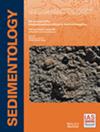下二叠统限制盆地(巴西南部西冈瓦纳)硅碎屑岩-碳酸盐混合沉积体系的高频古环境变化
IF 2.8
2区 地球科学
Q1 GEOLOGY
引用次数: 0
摘要
全球气候和古地理的变化在冈瓦纳西部二叠纪下统的浅海中产生了有机质积累较多的硅质碎屑岩-碳酸盐岩系统。巴拉那盆地厚 60 米的硅质碎屑岩-碳酸盐岩混合演替(Irati Formation 和 Serra Alta Formation 基底)是碳酸盐岩生成与硅质碎屑岩输入之间相互作用的独特记录,为将大规模沉积结构与岩相和地球化学分析结合起来提供了机会之窗。通过对岩心进行详细研究,并辅以露头柱状切片,发现了一个以硅质岩为主、从逆变到渐变的构造面,以及一个以碳酸盐为主、从渐变到顺变的混合构造面,这三个构造面组成了三个沉积序列,分别记录了外斜、中斜和上斜。通过对岩相和微岩相、有机地球化学和矿物成分进行综合描述,表明在这一狭长盆地的演化过程中,古环境发生了高频率的变化。气候的变化导致了潮湿和干燥阶段,为有机质的大量生产和白云岩的形成创造了理想的条件。高有机质的产生(潮湿阶段)以及受限的条件是造成缺氧底层水的原因,由于低角度和同向平台,缺氧底层水非常普遍。富含营养物质的淡水流入缺氧和高盐的受限盆地,形成了密度分层的水柱,造成了低盐度的表层水和缺氧的底层水,这使得湖泊中典型的浮游生物(如褐藻)在光照区大量繁殖,硫细菌在化学跃层以下大量繁殖。微生物活动促使原生白云石沉淀(干燥阶段),并广泛形成合成白云石。淡水流入和海洋入侵反映在有机质的积累上(分别为 I 型和 II 型角质),产生了总有机碳含量较高(5-27 wt.%)的沥青质页岩。本文章由计算机程序翻译,如有差异,请以英文原文为准。
High‐frequency palaeoenvironmental changes in the mixed siliciclastic–carbonate sedimentary system from a lower Permian restricted basin (West Gondwana, southern Brazil)
Global climatic and palaeogeographical changes generated a siliciclastic–carbonate system with high organic matter accumulations in a shallow sea during the lower Permian in Western Gondwana. The 60 m thick mixed siliciclastic–carbonate succession (Irati Formation and the base of the Serra Alta Formation) from the Paraná Basin represents a singular record of the interplay between carbonate production and siliciclastic input, providing a window of opportunity to integrate large‐scale depositional architecture with facies and geochemical analyses. The detailed study of cores supported by outcrop columnar sections revealed a siliciclastic‐dominated, retrogradational to aggradational facies, and a carbonate‐dominated, mixed aggradational to progradational facies composing three depositional sequences that record an outer‐ramp and mid to upper‐ramp. An integrated approach based on the description of facies and microfacies, organic geochemistry and mineralogical composition, indicated high‐frequency palaeoenvironmental changes during the evolution of this restricted basin. Climate changes, resulting in humid and dry phases, produced ideal conditions for high organic matter production and dolomite formation. The high organic matter production (humid phases) in addition to the restricted condition was responsible for the anoxic bottom waters that were widespread due to the low angle and homoclinal platform. Nutrient‐rich freshwater inflows in the anoxic and hypersaline restricted basin created a density‐stratified water column causing low‐salinity surface and anoxic bottom water, which allowed planktonic life, typical of lakes, such Botryococcus braunii , to flourish in the photic zone and sulphur bacteria to populate below the chemocline. Microbial activity induced primary dolomite precipitation (dry phases) and widespread formation of synsedimentary dolostone. Freshwater inflow and marine incursions are reflected in the organic matter accumulation (kerogen types I and II, respectively), generating bituminous shale with high total organic carbon (5 to 27 wt.%).
求助全文
通过发布文献求助,成功后即可免费获取论文全文。
去求助
来源期刊

Sedimentology
地学-地质学
CiteScore
8.20
自引率
11.40%
发文量
94
审稿时长
6-12 weeks
期刊介绍:
The international leader in its field, Sedimentology publishes ground-breaking research from across the spectrum of sedimentology, sedimentary geology and sedimentary geochemistry.
Areas covered include: experimental and theoretical grain transport; sediment fluxes; modern and ancient sedimentary environments; sequence stratigraphy sediment-organism interaction; palaeosoils; diagenesis; stable isotope geochemistry; environmental sedimentology
 求助内容:
求助内容: 应助结果提醒方式:
应助结果提醒方式:


